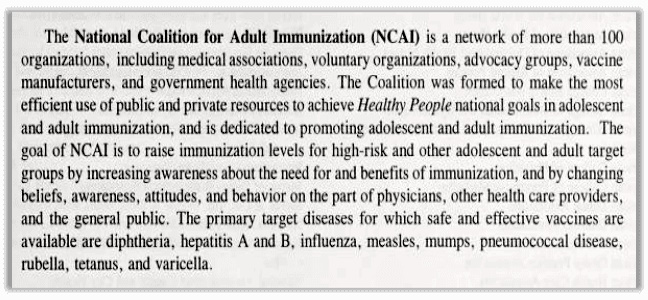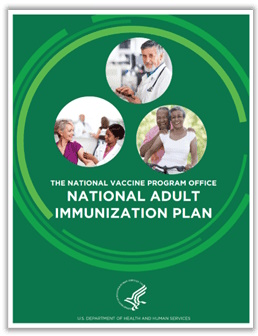Vaccines From Womb to Tomb
Vaccines From Womb to Tomb
Why Do We Have an Adult Immunization Schedule?
by Health Freedom Institute
May 2, 2024
Did you know that the CDC has an adult vaccination schedule?1 It’s been around for 22 years, growing and changing.2 Promotion of routine adult immunization started around 1990 but wasn’t formalized into a schedule until 2002.
The federal government has embraced vaccination as “a lifespan approach, covering vaccination from before birth into old age,”3 basically, from womb to tomb. This is laid out in its National Vaccination Plans, which were mandated by U.S. Congress in 1987.
The Adult Immunization Schedule has been a bit of a sleeper, but in recent years, when listening to the CDC’s Advisory Council on Immunization Practices (ACIP) meetings, we hear about it more and more. What changed? Let’s start at the beginning.
What Is the Adult Schedule?
In 1991, the CDC acknowledged in its weekly public health report that vaccination in adults wasn’t typical.4

The very first time the CDC pulled all their immunization recommendations into one place was in their weekly publication “Morbidity and Mortality Weekly Report” (MMWR) in 1969.5 Those recommendations laid the foundation for what we now recognize as the “schedule.” This first publication included dosage recommendations for adults, but those dosages generally were for shots missed in childhood or special circumstances like travel. It was not until many years later that the idea of an adult schedule was independently promoted. Other than influenza, the shots were targeted toward common childhood illnesses, and there wasn’t much to promote for adults.
The face of public health, and thus immunization, changed in 1979 when the federal Department of Health, Education, and Welfare (the predecessor to Health and Human Services) released a report titled “Healthy People: The Surgeon General’s Report on Health Promotion and Disease Prevention.”6 That publication marked the beginning of a new era of emphasis on population health. It was unique in its structured, data-driven approach to setting and surveilling health policy goals for our nation.7 This approach gave it longevity and flexibility and created the foundation for a new, decades-long infrastructure of setting health policy goals through identification of specific objectives with measurable targets, starting with “Healthy People 1990,” (launched in 1980) that continues to the latest “Healthy People 2030.”
The 1980s were tumultuous for vaccine policy. The expose “Vaccine Roulette” aired in 1982, helping parents across the country (and the globe) connect the dots on symptoms their children suddenly acquired after routine vaccination with DPT. The awareness congealed into a movement of parents who ignited a fire under U.S. Congress about the injustice of following the federally recommended childhood schedule only to find it was not safe for their babies. This outcry culminated in the National Childhood Vaccine Injury Act, known by many as the “1986 Act,” which removed liability from manufacturers. (You can do a deep dive on DPT in our article, “Shining a light on Pertussis & DPT: the vaccine that shut the courthouse doors.”)
While the 1986 Act was being debated, 1985 saw two measles outbreaks on college campuses.8 With vaccines in mind, a joint resolution was adopted by Congress that was signed by Ronald Reagan into law, acknowledging the last week in October as “National Adult Immunization Awareness Week.”9 The intent behind the resolution was to prevent deaths from influenza and pneumonia in older adults, but the college measles outbreaks were mentioned as justification for needing to raise awareness of vaccination among adults.10 Baked into federal adult immunization policy was the intent that the awareness week was “only the beginning.”
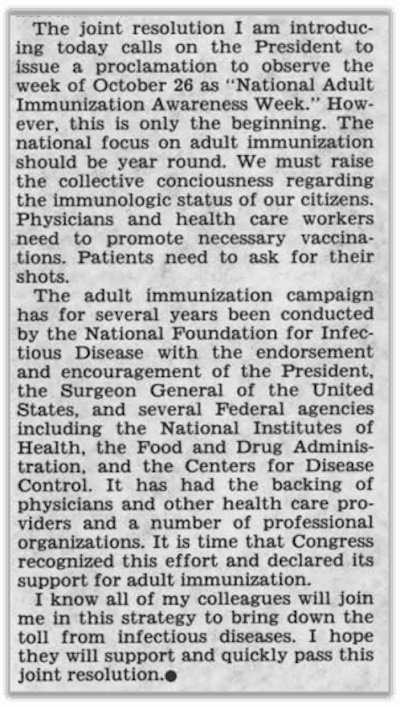
A National Coalition for Adult Immunization (NCAI) was formed shortly after, in 1988, to align “public and private resources to achieve Healthy People national goals.”
The 1979 report that inspired “Healthy People” only mentioned adult immunization in passing.

And the follow up report in 1980, “Promoting Health, Preventing Disease,” which came to be known as “Healthy People 1990,” provided 226 health policy goals with targets to be reached by 1990, but did not dive into adult vaccination.11

Regardless, the CDC fell in line with NCAI and started calling on doctors to include adult immunization as “a routine part of their practice.” In the 1991 publication where the CDC changed its tune on adult immunization, they reasoned that we couldn’t eliminate all illnesses because some adults were still “at risk” of getting sick from diseases on the childhood schedule if they were never vaccinated or weren’t sick in childhood. That said, there weren’t many action items because there weren’t many vaccines licensed to be marketed to adults.
After the 1986 Act, many vaccines were added to the childhood schedule. When the pneumococcal vaccine was added in 2001, it was licensed both for adolescents and adults. The promotion of adult vaccines picked up again for that moment in time. In 2002, the CDC unveiled its first official adult schedule. In short, healthy adults who had already been following the CDC’s childhood schedule were recommended annual flu shots, tetanus boosters every 10 years (generally at the time given in tandem with diphtheria as a TD shot), and the newly added pneumococcal recommendation for people who were 65 and over.
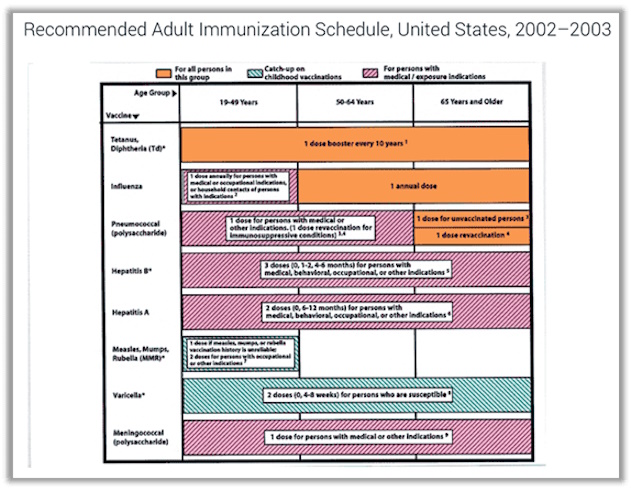
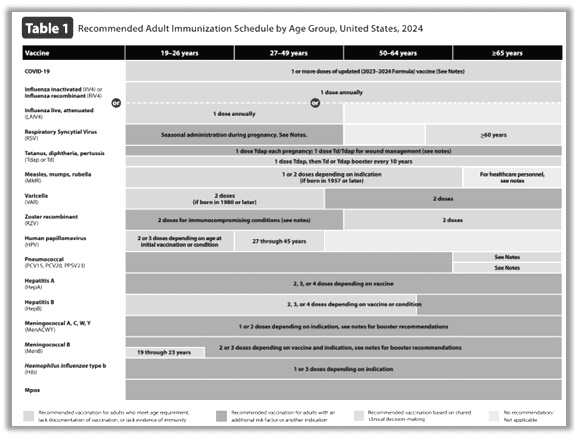
Note that right now COVID is recommended as “one or more doses,” which basically means there’s a blank check for how many shots will be recommended. The FDA and the CDC, along with their advisory committees (ACIP and VRBPAC respectively), have contemplated annual doses, but there’s also discussion of targeting strains. In other words, what will be recommended is yet to be seen.
One thing we can say for certain is that back in 2002 when the adult schedule table was first unveiled, the dose counts recommended were a lot lower.
Barriers to Success for the Adult Schedule
Simplification: The American Family Physician group says of the adult schedule, “The success of the childhood immunization program is partly because of the annual publication of the Recommended Childhood Immunization Schedule that summarizes the current recommendations and that it can be posted in the office for quick reference. We suggest that physicians post the Recommended Adult Immunization Schedule in the office as a quick reference tool and that it be used as part of a larger office-based program to improve adult immunization rates.”
Access: A study published on February 4, 2014, in the Annals of Internal Medicinerecommended that physicians refer patients to get the vaccines they did not stock to a pharmacy or public health department to get vaccinated.12 The reason for referring patients outside their clinic was either “lack of insurance coverage for the vaccine (55% for general internists and 62% for family physicians) or inadequate reimbursement (36% for general internists and 41% for family physicians).” Dr. Laura Hurley, one of the authors of the paper,13 that improving the delivery of recommended vaccines to adults will require a concerted effort to resolve financial barriers, especially for smaller practices and for general internists who see more patients with Medicare Part D.
In short, access comes down to whether a doctor is going to be paid enough to go to the trouble of stocking a shot.
The current White House has been promoting increased uptake of immunizing agents in adults. And the CDC, the agency in charge of getting “shots in arms,” has increased both propaganda and financial incentives. The 2023 Inflation Reduction Act (IRA), for example, was14
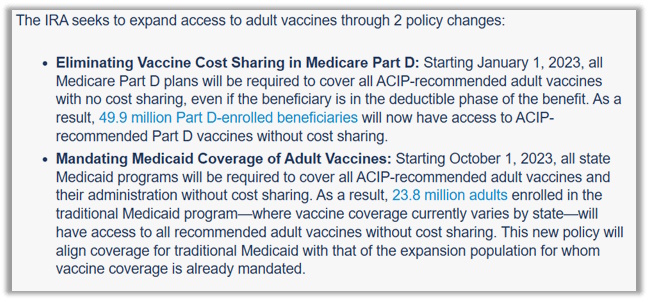
Conveniently, any American with Medicare or Medicaid can get any shot on the schedule at no cost to them. But some states did not require payment through their Medicaid for certain vaccines, and this federal law overrode their autonomy to decide how to spend taxpayer money. The new policy addresses that.
Biden’s policy follows the footsteps laid by Obama’s Affordable Care Act in 2010, which expanded access to vaccines with cost-sharing. The Healthy People plan was mentioned in the Affordable Care Act four times.15
The IRA law also highlights the importance of the schedule itself — insurance payments hinge on whether the vaccine is on the schedule, not simply whether it has been recommended. Not surprisingly, for the first time in history, the ACIP chose to update its annual schedule to a rolling schedule to keep up with all the anticipated changes and additional recommendations. For the first time in the history of the schedule, the ACIP left the last page blank so new recommendations could be quickly added through the year, rather than waiting for the annual update. This was done in the name of access.
You may have also been hearing of calls for financing called Vaccines for Adults. This will have to be legislated through the budget.
Why the Sudden Push for Vaccines for Adults?
A review of 100 vaccines in development by “Vaccines Today,” found a staggering 80% percent are aimed at adults.16 A survey of the vaccines and immunizing agents approved for use by the FDA over the past five years shows 11 of 15 can be marketed to adults, nine of which are only approved for those over 18 years of age.17 This is a shift from around the 1960s where we saw an explosion in new vaccines aimed at children, especially after the 1986 Act removed liability for injury from manufacturers and providers for shots on the childhood schedule.
The National Adult Immunization Plan
One of the goals of the plan is to simply increase demand. In other words, the federal government wants you to want these products. The plan was launched in 2015, a year after the CDC announced it was collaborating with Pfizer and a company called CECity to increase adult immunization rates.19 We know Pfizer makes vaccines (and “immunizing agents”); CECity is a company that specializes in electronic health records and was brought on board to implement a cloud-based “Adult Immunization Registry.” The initiative was released during the World Health Organization’s “Decade of Vaccines,” where their “Global Immunization Vision and Strategy 2006-2015” expanded the target group for routine immunizations to include adults.
The plan integrates health data transfer goals with calls for “interoperability” and “bidirectional exchange” of personal data between electronic health records (EHRs) and Immunization Information Systems (IIS’s).
Can adults injured by vaccines sue the manufacturer? It depends.
The 1986 Act and subsequent court cases removed liability from manufacturers and providers of vaccines if a person is injured or killed from vaccines. Does that apply to all vaccines? No, it only applies to shots that are on the childhood schedule. So if an adult takes a vaccine that is on the childhood schedule, like HPV or tetanus, they are bound by law to lose their right to a day in court and instead go through an administrative process many call “Vaccine Court,” which removes the right to a trial by jury. But if an adult takes the vaccine for shingles, which is not on the childhood schedule and therefore not under the umbrella of the VICP, an injured person can sue in court. It makes one wonder if those legal rights could be taken away and swept up into an amendment to the 1986 Act with a normalized Adult Immunization Schedule.
References:
- “Recommended Adult Immunization Schedule.” CDC. February 28, 2024. https://www.cdc.gov/vaccines/schedules/downloads/adult/adult-combined-schedule.pdf.
- “Recommended Adult Immunization Schedule–United States, 2002-2003.” MMWR Morb Mortal Wkly Rep., (2003): 52(15):345. https://pubmed.ncbi.nlm.nih.gov/12418546/.
- “2020 National Vaccine Plan Development: Recommendations from the National Vaccine Advisory Committee.” Public Health Reports, 135(2):181–188. https://pubmed.ncbi.nlm.nih.gov/12418546/.
- MMWR Morb Mortal Wkly Rep., (1991): 40(RR-12). v “ACIP Recommendations 1969: Collected Recommendations of the Public Health Service Advisory Committee on Immunization Practices.” National Communicable Disease Center 18, no. 43. https://stacks.cdc.gov/view/cdc/818.
- “Healthy People: The Surgeon General’s Report on Health Promotion and Disease Prevention.” Public Health Service 79-55071, U.S. Department of Health and Welfare (1979). https://files.eric.ed.gov/fulltext/ED186357.pdf.
- “The Evolution of the Healthy People Initiative: A Look Through the Decades.” J Public Health Manag Pract, (2021): 27(6):S225–S234. https://www.ncbi.nlm.nih.gov/pmc/articles/PMC8478310/. ↩︎
- “Current Trends Measles on College Campuses.” Morbidity and Mortality Weekly Report, (1985): 34(29);445-9. https://www.cdc.gov/mmwr/preview/mmwrhtml/00000581.htm.
- “Public Law 99-528.” Congressional Record, 99th Congress 132, (1986). https://www.govinfo.gov/content/pkg/STATUTE-100/pdf/STATUTE-100-Pg3009.pdf.
- Congressional Record, 99th Congress 132, part 15 (1986): 21399. https://www.congress.gov/bound-congressional-record/1986/08/13/senate-section?p=1.
- “Healthy People: The Surgeon General’s Report on Health Promotion and Disease Prevention.” Public Health Service 79-55071, U.S. Department of Health and Welfare (1979). https://files.eric.ed.gov/fulltext/ED186357.pdf.
- “Healthy People: The Surgeon General’s Report on Health Promotion and Disease Prevention.” Public Health Service 79-55071, U.S. Department of Health and Welfare (1979). https://files.eric.ed.gov/fulltext/ED186357.pdf.
- ”US Physicians’ Perspective of Adult Vaccine Delivery. Annals of Internal Medicine. Volume 160. No. 3. https://www.acpjournals.org/doi/10.7326/M13-2332?articleid=1819120
- “National Adult Immunization Plan.” U.S. Department of Health and Human Services. https://www.hhs.gov/sites/default/files/nvpo/national-adult-immunization-plan/naip.pdf.
- “Several Changes to Adult Vaccine Access Enacted Through IRA.” Avalere, (2022). https://avalere.com/insights/several-changes-to-adult-vaccine-access-enacted-through-ira.
- “Compilation of Patient Protection and Affordable Care Act.” U.S. House of Representatives, (2010). https://housedocs.house.gov/energycommerce/ppacacon.pdf.
- Future of Immunisation: 100 Vaccines in the Pipeline.” Vaccines Today, Gary Finnegan (2023). https://www.vaccinestoday.eu/stories/future-of-immunisation-100-vaccines-in-the-pipeline/.
- “Biological Approvals by Year.” The Center for Biologics Evaluation and Research, U.S.FDA (2024). https://www.fda.gov/vaccines-blood-biologics/development-approval-process-cber/biological-approvals-year.
- “Adult Immunization Plans.” U.S. Department of Health and Human Services, (2019). https://www.hhs.gov/vaccines/national-adult-immunization-plan/index.html.
- “American College of Physicians, CECity, and Pfizer Collaborate to Increase Adult Immunization Rates.” Pfizer, (2014). https://www.pfizer.com/news/press-release/press-release-detail/american_college_of_physicians_cecity_and_pfizer_collaborate_to_increase_adult_immunization_rates
Connect with Health Freedom Institute
Cover image credit: TCTL with creative commons images by larspromotion & OpenClipart-Vectors
